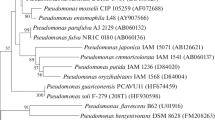Abstract
The Penicillium frequentans strain Bi 7/2, using phenol as a sole source of carbon and energy,transformed the fluorinated phenols 2,3-, 2,4-, 2,5-and 3,4-difluorophenol rapidly. After growth on phenol, resting mycelia of the fungus converted the difluorophenols completely at an initial concentration of 0.5 mM within 6 hours. The corresponding difluorinated catechols were found to be intermediates of all difluorophenols investigated. A relatively unspecific phenol hydroxylase catalyzed this hydroxylation step and showed activities towards all difluorophenols tested. One difluorocatechol was formed from each difluorophenol substituted with fluorine in the ortho-position, whereas two catechols were formed from 3,4-difluorophenol, due to its two vacant ortho-positions. A partial defluorination (50-77%) was observed in all cases.
Similar content being viewed by others
References
Becker HGO & Berger W et al. (1996) In: Organikum: Organischchemisches Grundpraktikum (p 599). Johann Ambrosius Barth Verlag, Heidelberg; Leipzig
Bilton RF & Cain RB (1968) The metabolism of aromatic acids by microorganisms. A reassessment of the role of obenzochinone as a product of protocatechuate metabolism by fungi. Biochem. J. 108: 1113–1117
Cociglio M, Brandissou S, Alric R & Bressolle F (1996) Highperformance liquid chromatographic determination of fluconazole in plasma. J. Chromatogr. B. 686: 11–17
Corse J & Ingraham LL (1951) The monofluorocatechols. J. Org. Chem. 16: 1345–1348
Dorn E & Knackmuss HJ (1978) Chemical structure and biodegradability of halogenated aromatic compounds.Biochem. J. 174: 85–94
Engesser KH, Auling G, Busse J & Knackmuss HJ (1990) 3fluorobenzoate enriched bacterial strain FLB 300 degrades benzoate and all three isomeric monofluorobenzoates. Arch. Microbiol. 153: 193–199
Gerstenberger WRC & Haas A (1981) Fluorierungsmethoden in der Organischen Chemie. Angew. Chem. 93: 659–680, Angew. Chem. Int. Ed. Engl. 20: 647-668
Goldman P (1965) The enzymatic cleavage of the carbonfluorine bond in fluoroacetate.J. Biol. Chem.240: 3434–3438
Harper DB & Blakley ER (1970) The metabolism of pfluorophenylacetic acid by a Pseudomonas sp. I. Isolation and idenbiod459. tification of intermediates in degradation.Can. J. Microbiol. 17: 635–644
Harper DB & Blakley ER (1971) Themetabolism of pfluorobenzoic acid by a Pseudomonas sp. Can. J. Microbiol. 17: 635–644
Hofrichter M, G¨unther Th & Fritsche W (1993) Metabolism of phenol, chloroand nitrophenols by the Penicilliumstrain Bi 7/2 isolated from a contaminated soil. Biodegradation 3: 415–421
HofrichterM, Bublitz F & FritscheW(1994) Unspecific degradation of halogenated phenols by the soil fungus Penicillium frequentansBi 7/2. J. Basic Microbiol. 34: 163–172
Hofrichter M, Bublitz F & FritscheW(1995) Cometabolic degradation of ocresol and 2,6dimethylphenol by Penicillium frequentansBi 7/2. J. Basic Microbiol. 35: 303–313
Key BD, Howell RD, Criddle CS (1997) Fluorinated organics in the biosphere. Environ. Sci. Technol. 31: 2445–2454
Ladd DL & Weinstock J (1981) Improved synthesis of fluoroveratroles and fluorophenethylamines via organolithium reagents. J. Org. Chem. 46: 203–206
Marr J, Kremer S, Sterner O & Anke H (1996) Transformation andmineralization of halophenols by Penicillium simplicissimumSK9117. Biodegradation 7: 165–171
Naumann K (1994) Neue Insektizide. Nachr. Chem. Tech. Lab. 42: 255–260
Neilson AH (1990) The biodegradation of halogenated organic compounds. J. Appl. Bacteriol. 69: 445–470
Neujahr HY & Varga JM (1970) Degradation of phenols by intact cells and cellfree preparations of Trichosporon cutaneum. Eur. J. Biochem. 13: 37–44
Oltmanns RH, M¨uller R, Otto MK & Lingens F (1989) Evidence for a new pathway in the bacterial degradation of 4fluorobenzoate. Appl. Environ. Microbiol. 55: 2499–2504
Polnisch E, Kneifel H, Franzke H & Hofmann HH (1992) Degradation and dehalogenation of monochlorophenols by the phenol assimilating yeast Candida maltosa. Biodegradation 2: 193–199
Reinecke W (1988) Microbial degradation of haloaromatics. Ann. Rev. Microbiol. 42: 263–287
RochkindDubinsky ML, Sayler GS & Blackburn JW(1987) Microbial decomposition of chlorinated aromatic compounds. Marcel
Dekker, New York and Basel Schl¨omann M, Fischer P, Schmidt E, Knackmuss HJ (1990) Enzymatic formation, stability, and spontaneous reactions of 4fluoromuconolactone, a metabolite of bacterial degradation of 4fluorobenzoate. J. Bacteriol. 172: 5119–5129
Visscher PT, Culbertson CW & Oremland RS (1994) Degradation of trifluoroacetate in oxic and anoxic sediments. Nature 369: 729–731
Wong HD, Kirkpatrick WE, King DR & Kinnear JE (1992) Defluorination of sodium monofluoracetate (1080) by microorganisms isolated from western australian soils. Soil Biol. Biochem. 24: 833–838
Ziechmann W (1994) Humic Substances. BI Wissenschaftsverlag, Mannheim; Leipzig; Wien; Z¨urich
Author information
Authors and Affiliations
Rights and permissions
About this article
Cite this article
Wunderwald, U., Hofrichter, M., Kreisel, G. et al. Transformation of difluorinated phenols by Penicillium frequentans Bi 7/2. Biodegradation 8, 379–385 (1997). https://doi.org/10.1023/A:1008230926973
Issue Date:
DOI: https://doi.org/10.1023/A:1008230926973



